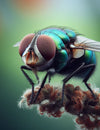
Are you tired of the unsettling presence of flying cockroaches in your living space? The incessant fluttering and unwelcome surprises can turn any home into a source of distress. Fear not, for we have compiled an invaluable guide on how to get rid of flying cockroaches. These resilient pests can be a challenge to tackle, but armed with the right knowledge and strategies, you can reclaim your space and ensure a roach-free environment. From understanding their behavior to implementing effective prevention and natural remedies, this comprehensive guide will empower you to face the airborne invasion head-on. Say goodbye to unwanted winged guests as we explore practical solutions to keep your home cockroach-free.
Do All Cockroaches Fly?
Cockroaches are renowned for their adaptability and resilience, but not all of them take to the skies. While there are over 4,500 species of cockroaches worldwide, only a handful have developed the ability to fly. The most common flying cockroach species include the American Cockroach, Oriental Cockroach, and the infamous German Cockroach. These airborne capabilities vary in effectiveness and purpose among species. For instance, some cockroaches use their wings primarily for gliding short distances, while others may take flight in search of mates or new food sources. It's essential to identify the specific type infesting your space to tailor your approach effectively. Understanding the reasons behind their flight can be the first step in formulating a strategy to eliminate these winged intruders from your home.
Difference Between Flying & Non-Flying Cockroaches
The distinction between flying and non-flying cockroaches extends beyond the obvious presence or absence of wings. Understanding these differences is crucial for implementing targeted pest control measures.
-
Physical Characteristics: Flying cockroaches typically have longer wings compared to their non-flying counterparts. The wings of flying cockroaches extend beyond the length of their bodies, providing them with the ability to take to the air. Non-flying cockroaches, on the other hand, may have underdeveloped wings or none at all.
-
Behavioral Variances: The behavior of flying and non-flying cockroaches differs significantly. Flying cockroaches often use their wings for short bursts of flight, especially when seeking mates or escaping perceived threats. Non-flying cockroaches, lacking this capability, rely on their speed and agility to navigate their environment.
-
Habitat Preferences: The ability to fly also influences the habitat preferences of cockroach species. Flying cockroaches may be more likely to inhabit upper floors of buildings or spaces with easier access to outdoor environments. Non-flying cockroaches, constrained to crawling, might be found predominantly on lower levels.
-
Species-Specific Traits: Different cockroach species exhibit varying degrees of flight capability. Some species are adept fliers, while others may have wings that are functionally useless. Understanding the specific traits of the cockroach infesting your space is crucial for effective pest management.
By recognizing these distinctions, you can gain insights into the habits and vulnerabilities of the cockroaches in your home, allowing for a more targeted and strategic approach to pest control.
Why Is It Difficult to Eliminate Flying Cockroaches Than Non-Flying?
Eliminating flying cockroaches presents a unique set of challenges compared to their non-flying counterparts. Understanding the reasons behind this difficulty is crucial for developing effective pest control strategies.
-
Increased Mobility: Flying cockroaches have a distinct advantage in terms of mobility. Their ability to take to the air allows them to cover larger distances quickly, making it challenging to track and target them compared to non-flying cockroaches that are confined to crawling.
-
Hard-to-Reach Spaces: The airborne capabilities of flying cockroaches enable them to access hard-to-reach spaces within your home. They can easily navigate upper floors, attics, and other elevated areas, making it difficult to locate and eliminate their hiding spots.
-
Varied Entry Points: Flying cockroaches often enter homes through open windows, vents, or other openings that are not typically associated with crawling pests. This varied entry points make it challenging to seal off all potential access routes, unlike with non-flying cockroaches that rely on ground-level entry.
-
Adaptability to Environment: Flying cockroaches are generally more adaptable to changes in their environment. They can quickly relocate to new areas if they sense threats or discover a lack of resources. This adaptability makes it challenging to predict and control their movements effectively.
-
Extended Breeding Range: The ability to fly also extends the breeding range of cockroaches. Flying individuals can locate mates over greater distances, leading to potentially larger infestations. This extended range complicates efforts to control their population and prevent the spread of these resilient pests.
To overcome the challenges posed by flying cockroaches, a comprehensive and strategic approach that takes into account their increased mobility and adaptability is essential. From sealing entry points to targeted treatments, addressing these challenges head-on is key to successfully eliminating flying cockroach infestations.
Natural & Effective Ways to Eliminate Flying Cockroaches
When dealing with flying cockroaches, a natural and chemical-free approach can be both effective and environmentally friendly. These methods not only help eradicate existing infestations but also serve as preventative measures to deter these pests from returning.
-
Diatomaceous Earth: Harness the power of diatomaceous earth, a fine powder derived from fossilized algae. Sprinkle it liberally in areas frequented by flying cockroaches. Upon contact, the powder damages their exoskeletons, leading to dehydration and eventual demise. It's a natural and harmless solution for both humans and pets.
-
Essential Oils: Utilize the insect-repelling properties of essential oils like peppermint, citronella, and eucalyptus. Create a simple DIY solution by mixing a few drops of these oils with water and spray it in cockroach-prone areas. The potent scents act as a deterrent, disrupting their navigation.
-
Bay Leaves: Discover the natural cockroach-repelling abilities of bay leaves, a common kitchen ingredient. Strategically place bay leaves in areas where flying cockroaches are likely to gather. The compounds in bay leaves act as a natural deterrent, offering a cost-effective and accessible solution.
-
Boric Acid: Leverage the power of boric acid, a mineral widely used in pest control. Create a paste by combining boric acid with water and sugar, then place it in areas frequented by cockroaches. The sugar attracts them, while the boric acid acts as a lethal agent, effectively eliminating the pests.
-
Cucumber Peels: Embrace an unexpected solution by using cucumber peels as a natural cockroach deterrent. Place these peels near entry points and areas prone to infestations. The aroma of cucumber repels cockroaches without posing any threat to humans or pets.
-
Cockroach Killer Gel: Consider using a specialized cockroach killer gel, a targeted and efficient solution. Apply the gel in areas where cockroaches are active, focusing on cracks, crevices, and other hiding spots. The gel attracts and eliminates the pests effectively, providing a convenient option for targeted control.
-
Cleanliness Is Key: Never underestimate the power of cleanliness in pest control. Maintain a spotless living space by regularly cleaning surfaces, vacuuming floors, and storing food in airtight containers. By denying flying cockroaches access to food sources and hiding spots, you create an environment that discourages their presence naturally.
Incorporating these natural methods, along with a reliable cockroach killer gel, into your pest control routine ensures a well-rounded and effective strategy for eliminating flying cockroaches and maintaining a healthy home environment.



